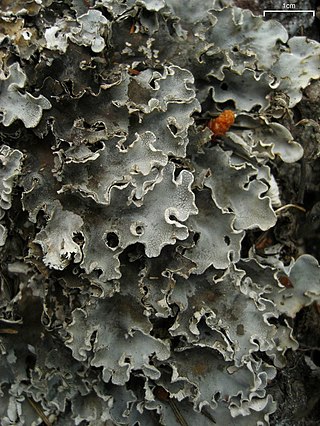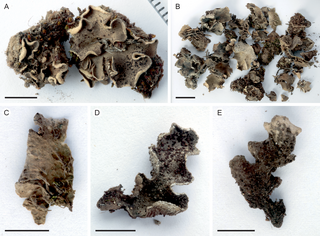
Peltigera is a genus of approximately 100 species of foliose lichens in the family Peltigeraceae. Commonly known as the dog or pelt lichens, species of Peltigera are often terricolous, but can also occur on moss, trees, rocks, and many other substrates in many parts of the world.

Anzia is a genus of foliose lichens known as black-foam lichens in the large family Parmeliaceae. It was formerly included in the monogeneric family Anziaceae, but this has since been subsumed into the Parmeliaceae.
Peltigera vainioi is a species of lichen in the family Peltigeraceae. It is found in high-elevation locations in South America. It is a somewhat unusual species in its genus, characterized by a single holdfast that attaches to its substrate, and pores in its cortex.

Peltigera degenii is a species of foliose lichen in the family Peltigeraceae. It was first formally described in 1927 by Hungarian lichenologist Vilmos Kőfaragó-Gyelnik. The Chinese species Peltigera neodegenii is similar in appearance. Peltigera degenii has a shiny upper surface. In North America, it is a relatively rare forest species.

Punctelia graminicola is a species of foliose (leafy) lichen in the family Parmeliaceae. It grows on rocks, and, less frequently, on bark in North America, South America, and East Africa. It has a blue-grey thallus measuring up to about 15 cm (6 in), covered with tiny pores called pseudocyphellae. Sometimes the lichen forms small lobes that project out from the surface. Fruiting bodies are uncommon in this species; if present, they resemble small cups with a brown internal disc measuring 3–10 mm (0.1–0.4 in) in diameter. A lookalike species, Punctelia hypoleucites, is not readily distinguishable from Punctelia graminicola by appearance or habitat alone; these species can only be reliably differentiated by examining the length of their conidia.
Peltigera papuana is a lichen-forming fungus in the family Peltigeraceae. It was described in 2009 from Madang Province of Papua New Guinea, which inspired its specific epithet. Genetic analysis of both the mycobiont and the photobiont, which is a Nostoc cyanobacterium, suggests that the evolutionary origin of Pelitgera papuana is from an ancient dispersal event from South America, although this remains inconclusive.

Peltigera rufescens, the field dog lichen or field pelt, is a species of terricolous (ground-dwelling), foliose lichen in the family Peltigeraceae. The common and widespread species has a cosmopolitan distribution. The lichen has a surface that is densely covered with a soft, velvety layer, extending from the edges to the centre. The edges of this lichen typically curl upwards, revealing lobes that can be up to 10 millimetres wide. Beneath, it possesses a network of rhizines, which are root-like structures that merge together into a thick mat, anchoring the lichen to its substrate.
Peltigera wulingensis is a species of terricolous (ground-dwelling), foliose lichen in the family Peltigeraceae. Originally described from specimens found in northern China, it has since been recorded in Canada, Norway, and Russia.
Verrucaria oulankaensis is a rare species of saxicolous (rock-dwelling) crustose lichen in the family Verrucariaceae. It is found in north-eastern Finland, where it occurs on calcareous rocks on river shores.

Lichenomphalia hudsoniana is a species of basidiolichen in the family Hygrophoraceae. It is widely distributed in alpine and arctic regions of the world, where it grows on moist soil amongst moss.
Peltigera seneca is a rare species of foliose lichen in the family Peltigeraceae. Native to eastern North America, it was first identified in Pennsylvania's Tioga State Forest, where it grows on humus and mossy rocks. It is similar to the Peltigera polydactylon, but with distinct genetic, geographic, and chemical characteristics. P. seneca is characterized by its small thalli with narrow lobes and a pale zone on margins of its lower thallus surface.

Peltigera hydrophila is a species of foliose lichen in the family Peltigeraceae. First described in 2020, it distinguishes itself through a distinct, hairless thallus that turns deep blue-violet when it becomes wet. Found primarily in the Magallanes Region of Chile, this small leafy lichen clings closely to mosses and other substrates. Distinctive features include the always-present reddish-brown to dark brown apothecia and the Peltigera-type ascospores that contain three internal partitions, or septa. Despite sharing a habitat with similar species like P. aubertii and P. frigida, P. hydrophila sets itself apart through its unique thallus surface texture and colour. This semi-aquatic lichen primarily thrives in humid forests, shrubby and herbaceous vegetation in southern Chile, particularly near waterfalls, streams, and other wet environments.

Verseghya thysanophora, commonly known as the mapledust lichen, is a species of mostly corticolous (bark-dwelling), leprose lichen in the family Pertusariaceae. This common species is widely distributed in the Northern Hemisphere. The thallus of the lichen is a thin patchy layer of granular soredia, pale green to yellowish green in colour. The main characteristics of the lichen include the presence of lichen products known as thysanophora unknowns, and the conspicuous white, fibrous prothallus that encircles the thallus.
Placolecis kunmingensis is a species of saxicolous (rock-dwelling), crustose lichen in the family Catillariaceae. It is found in Yunnan, China. The lichen is characterised by a thallus that is areolate to squamulose in its centre, forming irregular patches or clumps 10–50 mm wide, as well as its ellipsoid or spherical ascospores with slightly thickened wall.
Placolecis sublaevis is a species of saxicolous (rock-dwelling), crustose lichen in the family Catillariaceae. It is found in Yunnan and Sichuan, China. The crust-like, radiating body of the lichen forms irregular patches or clumps and includes numerous false conidiomata, a type of asexual reproductive structure, within its thallus. Its lobes, dark brown and slightly flattened at the top, form larger groups at the edges and contain an upper layer composed of loosely interwoven cells and a lower inner tissue that varies from reddish-orange to white.
Upretia squamulosa is a species of saxicolous (rock-dwelling), squamulose (scaly) lichen in the family Teloschistaceae. It was identified as a new species in 2019 from specimens collected in the arid valley of the Jinsha River in Yunnan, China.

Peltigera cinnamomea, the dog pelt or cinnamon-pelt lichen, is a species of muscicolous (moss-dwelling), foliose lichen in the family Peltigeraceae. The species was formally described by the Canadian lichenologist Trevor Goward in 1995. The lichen is found in forested regions of northwestern North America, particularly in the unique montane and subalpine forest communities of the northern Rocky Mountains. Notably, Peltigera cinnamomea thrives under prolonged snow cover, surviving well into the spring, which distinguishes it from many of the other Peltigera species that inhabit similar North American forest ecosystems.

Peltigera castanea is a species of terricolous and muscicolous, foliose lichen in the family Peltigeraceae. Described as a new species in 2003, it is part of the taxonomically challenging species complex centred around Peltigera didactyla. Recognised based on phylogenetic studies that highlighted its unique genetic markers, P. castanea is distinguished by its dark, chestnut-coloured upper surface, which inspired its vernacular name, chestnut pelt lichen. Its known distribution includes North America, Asia, Europe (Estonia), Greenland, and the Antarctic. The conservation status of Peltigera castanea varies regionally, from being critically imperiled in British Columbia and Yukon to critically endangered in Estonia due to significant habitat degradation and restricted population size.

Peltigera alkalicola is a rare species of terricolous (ground-dwelling) foliose lichen in the family Peltigeraceae. First described in 2022 from specimens collected in the Kilimanjaro National Park in Tanzania, it is characterised by its unique ecological preferences. Analysis of DNA samples indicate that the lichen may also occur in Alaska, USA, and Ningxia, China, suggesting a wider distribution in cold, montane ecosystems.
Peltigera isidiophora is a species of foliose lichen in the family Peltigeraceae. It is characterised by its laminal clustered isidia that grow in pits, a shiny and scarred grey upper surface, and its thin, sparse, and simple rhizines. It is known only from its original collection location in Hebei, China, where it grows on moss and on soil in montane forest.










